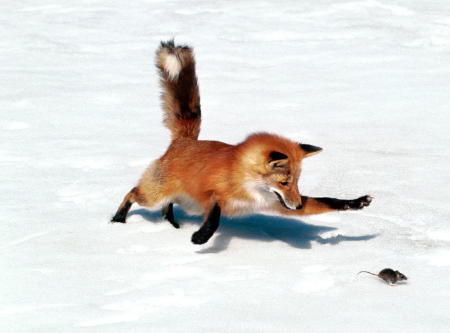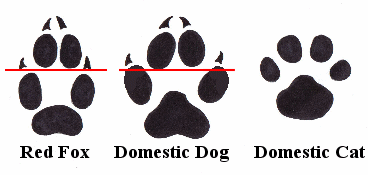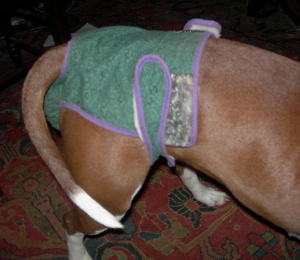





|
|
|
|
February 27, 2007
No outfoxing nature here!
Coco is in heat. Yes, it happens twice a year, and it requires me to pay a bit more attention to potential, um, situations, than I normally do. It certainly isn't like the old days, when male dogs roamed about, and having a bitch in heat would cause untold commotion, stalking, and desperate howling late at night. These days, it's almost as if nothing is happening. Even though the scent can be detected for miles, people don't let their dogs roam, and there are almost no male dogs who still have their nuts. Of course, almost is not 100%. There's always that chance, so I remain vigilant. Thanks to the fresh snow on Sunday night, I learned that there is a late-night frequenter to the property who has left tracks demonstrating a keen interest in Coco. Odd, because as I said, there aren't any dogs that wander, or else they'd be waiting for her in the yard. But this is no dog. Coco's nocturnal admirer is (I am sure) a fox. A red fox (Vulpes vulpes to be exact). It looks like this one:  I've seen the fox in the yard before, and Coco has a disturbing habit of rummaging around in the bushes where he lives, and I suspect she's eating something I'd rather not think about, and where I'd rather not "go" in this nice clean blog post. But she's familiar with him, and after looking at the tracks carefully, I'm sure they're from the fox. They're longer and skinnier than normal dog footprints, and... Hell, here's a picture showing the difference:  It's a match with the tracks in the snow. Furthermore, the fox tracks went right through the hedge without any hesitation, and then looped around and through the yard, then through the neighbor's yard, as if this was an extended detour from its normal nighttime prowling route. There were a lot of tracks circling this house, and around Coco's little spots of yellow snow. Naturally, a "what if" scenario crossed my mind. While it certainly isn't my goal to play mad scientist with my dog, it did occur to me that mating with the fox would not be a physical impossibility, and that if I left her in the yard in the wee hours of the morning, that little guy might just take a shot at it. Foxes are wily creatures, though, and thousands of years of experience in avoiding man would naturally make them hesitant to get caught in a tie-up (from which escape is impossible for twenty minutes or so). But lets say that for whatever reason, the deed took place. According to virtually every source I have consulted, the odds are overwhelmingly against a successful pregnancy, because there is said to be a chromosomal incompatibility. Foxes and dogs are in the Family Canidae, but foxes are in the subgenus Vulpes, and cannot interbreed with dogs the way wolves and coyotes can. If pregnancy did occur, the theoretical result would be a "Dox": Contrary to popular myth, dogs cannot successfully interbreed with red foxes. Dogs have 78 chromosomes, but red foxes have only 38 chromosomes.* This severe mismatch is a barrier to hybridisation. In spite of anecdotal evidence of hybrids and claims that hybrids are superior to ordinary dogs, there have been no genetically verified "doxes".While there's been an ongoing fox domestication program in Russia for 45 years, no one appears to have made a serious effort to breed dogs with foxes. Outside of scientific curiosity, I don't know why anyone would, as the fox is a very different animal with very different instincts and behavior, and has a strong scent which is said to be most unpleasant. The offspring would probably be sterile, and most likely would have miserable lives. I'm not about to try, but that doesn't mean I trust Coco. Right now, she's wearing a very stylish diaper to keep her discharge from staining up the whole house:  I don't know, but if I were a fox, I might think she looked foxy! But I'm in no mood to make genetic history right now. Besides, Coco couldn't take the publicity. * Chromosome differences alone are not an absolute bar. Wiki's discussion of "humanzees" states that "having different numbers of chromosomes is not an absolute barrier to hybridization." (There are tions, ligers, and the beefalos.... Oh my!) posted by Eric on 02.27.07 at 09:47 PM
Comments
Wouldn't Coco just kill a fox? I thought that was built into most dogs... hatred or fear of wolves and foxes. Harkonnendog · February 28, 2007 04:25 PM Yeah, you might think so Hark, but Coco takes a very strange look at these things. I think she believes it is a doglike creature, and thus more entitled to life than her normal enemies (deer and squirrel). Eric Scheie · February 28, 2007 11:54 PM Post a comment
You may use basic HTML for formatting.
|
|
February 2007
WORLD-WIDE CALENDAR
Search the Site
E-mail
Classics To Go
Archives
February 2007
January 2007 December 2006 November 2006 October 2006 September 2006 August 2006 July 2006 June 2006 May 2006 April 2006 March 2006 February 2006 January 2006 December 2005 November 2005 October 2005 September 2005 August 2005 July 2005 June 2005 May 2005 April 2005 March 2005 February 2005 January 2005 December 2004 November 2004 October 2004 September 2004 August 2004 July 2004 June 2004 May 2004 April 2004 March 2004 February 2004 January 2004 December 2003 November 2003 October 2003 September 2003 August 2003 July 2003 June 2003 May 2003 May 2002 See more archives here Old (Blogspot) archives
Recent Entries
• Why hypocrisy shouldn't -- but does -- matter
• New Vistas • Basta La Vista? • I try not to take personal wars personally.... • Come celebrate America's traditional values! • Gang Rape of Israeli Girls by Arabs • No outfoxing nature here! • Avoiding an unfair comparison • Latest Medal of Honor Recipient • Conflating Nazism with Islam?
Links
Site Credits
|
|
The problem is more with how certain genes line up in the gender related chromosomes. Because there is a near match in the case of horses and donkeys, they can breed and produce mules. Human's and chimpanzees don't match up, so no humanzees.
Then sometimes you get partial matches. That would appear to be the case with domestic cats and servals, which is how we got the Savannah breed. This might be the case with vulpines and canines.